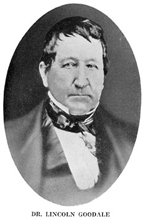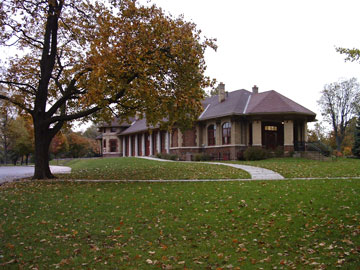
Columbus, Ohio USA
Return to Homepage www.shortnorth.com
The Short North That Was
Dr. Lincoln Goodale and His Living Legacy
Part Seven
June 2007 Issue
by Beverly Mullet Randall
email bmullet@netwalk.com
Goodale Park - At The Center of History's Crossroads, The Early 1900s
Dr. Lincoln Goodale, Courtesy of the Columbus Metropolitan Library, Division of Biography, History & Travel With the exception of residential housing, the Goodale Park area had remained fairly undeveloped until the city started extending gas, water and electricity to this sector in the 1870s and 1880s. These services, combined with the proximity of railroads, highways, and waterways, created ideal conditions for industrial development that included an iron foundry and The United States Pipe and Foundry Company in the 1870s, Columbus Forge and Drum Company and the Commercial Paste Company in 1900, and the Franklin Lumber and Furniture Company in 1901. The Columbus, Piqua and Indianapolis Railroad was another large employer. When Rosenthal Brothers Wool-Pullers opened on Spruce Street, there was a housing shortage for their workers. Housing “flew up” almost overnight in the area known as “Flytown” to accommodate these workers.
The Goodale Park area became Central Ohio’s port-of-entry for Italians, Jews, Irish, Hungarians and others, forming a melting pot of cultures living in cheap, quickly constructed two- and three-story wood-and-brick tenements crammed into the Flytown. With this influx of workers and new industries came the grocers, bakers, watchmakers, shoemakers, clothiers and other craftsmen and services needed by the workers. There were so many Italian grocers in the area, some still located along Goodale Street until the late 1950s, that some say the “Flytown” name derived from the flies attracted to the produce stands. Flytown is often remembered sentimentally as a place where 17 different nationalities and cultures lived side-by-side; a place of togetherness blended with workingman toughness; a colorful place with gypsies roaming the streets in the late spring. This group’s willingness to blend its individual differences into an amalgamated, singularly American experience has been recognized as a truly unique event in history.
In the midst of this bustle and din was, once again, Goodale Park, Lincoln Goodale’s gift of greenery and natural beauty for the people. These were years of high usage of the park by the local citizenry. In the past, there were often complaints about vandals, bullies, noisy people and “frail women” who were possibly prostitutes, and some of this appears to have continued. A 1951 Columbus Citizen column by Ben Hayes alludes to this with a retelling of a joke told by Bobbie Gossens with Vogel’s Minstrels during their Columbus run in 1907: “Did you know they are going to change the name of Goodale Park?”
“No. Are they?”
“Yes, they are going to change it to Orchard Park – they find so many pairs under the trees.”
The Goodale Park Shelter House was built in 1912. Its natural limestone pillars and decorative brick patterns show its kinship to the Arts and Crafts Movement which was a reaction to the often shoddy and aesthetically unappealing architecture of the Industrial Revolution. © Photo by Beverly Mullet Randall By 1912, Flytown bordered the south and east sides of Goodale Park. While the area around Goodale Park was changing rapidly, very few dramatic changes were made to the park itself during this era other than the construction of the new Shelter House in 1912. The park’s first shelter house was built in 1853 but it had no gas, electricity or water. The 1912 Shelter House not only incorporated these services, but is also considered to be a prime example of the Arts and Crafts Movement. Architecture from this movement has been described as a rebellion against the shoddy materials used in construction during the Industrial Revolution. Hallmarks of Arts and Crafts architecture include use of natural materials such as the shelter’s limestone columns, and decorative brick patterns for ornamental effect. The 1912 Shelter House was the last substantial building constructed in Goodale Park and it still exists today – even though some changes have been made to it over the years, the renovators were careful to preserve its architectural integrity and overall appearance.
The 1930s and 1940s
After the Great Depression, President Roosevelt started the Works Progress Administration, later called the Work Projects Administration (WPA) in 1935. Some of the WPA funds for Columbus rebuilt both lakes in Goodale Park. The lakes were drained, cleaned and the edges were lined with stone.
The 1940s brought Dutch Elm disease to Columbus and Goodale Park, decimating most of the beautiful elm trees. Many of the elm trees in Goodale Park died but some managed to survive, more notably the large elm that stood by the Lincoln Goodale statue until lightning hit it in the 1990s. With World War II going on, the city had to wait until after the war was over to hire men to cut down the dead trees and replant.The 1951 Centennial Celebration
The 1950s in Goodale Park began with the Centennial Celebration. Originally scheduled to be a two-day event in September, the program was shortened to Sunday only. Prior to the celebration, the city drained and cleaned both lakes and reduced the size of the older lake now referred to as the lagoon. At this time, the old White Cross Hospital still overlooked the lagoon. The city also trimmed the park’s shrubs and grass to beautify it for its celebration.
Over 300 spectators attended the event that began with the reopening of the lagoon, featuring The Clinton Conservation Club, the Hilltop Casting Club and a casting demonstration. Then came the band and drill team exhibitions, including 50 children of the Loyal Temperance Legion executing a flag drill. Boy Scouts sold a 28-page centennial booklet for 25 cents. The Ohio State Museum and the United Commercial Travelers (UCT) set up a display of historical exhibits in the UCT building bordering the park which was formerly circus man Peter Sells residence. Some of the items on display were a portrait of Dr. Lincoln Goodale and the sword of Maj. Nathan Goodale, Lincoln’s father. Some of Dr. Goodale’s heirs were also present.
In the evening, a pageant, “Let’s Go Back,” depicted scenes from the park’s history such as its days as a Civil War camp, Memorial Day celebrations, and the tent meetings held on the grounds by the famous evangelist, Billy Sunday. Miss June Wynters of the Wynters School of Expression directed the pageant.
One of the more notable park history scenes depicted was Dr. Lincoln Goodale presenting the deed of the land for the park to Columbus Mayor Lorenzo English in 1851. Wearing a frock coat, ruffles and shoe-string tie, Henry Koontz, the 1951 City Council president, depicted Dr. Lincoln Goodale handing the land deed to James A. Rhodes, the Mayor of Columbus in 1951, who was depicting Mayor English. Although this was not entirely historically accurate since there was no ceremony with the original transfer of the deed, it was reported that the pageant brought twinges of nostalgia for spectators who could remember back to the early days of the park. The event ended with an historical address by Dr. Harold Yochum, then president of Capital University – Dr. Goodale had also donated the original land for Capital University’s first location bordering the park land.Special thanks to local historian Terry Sherburn.
©2007 Short North Gazette, Columbus, Ohio. All rights reserved.

